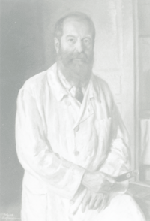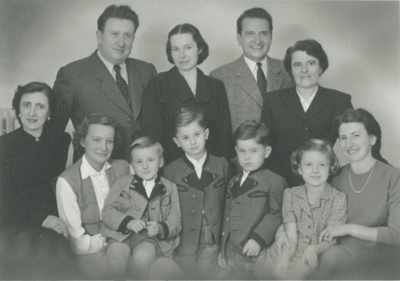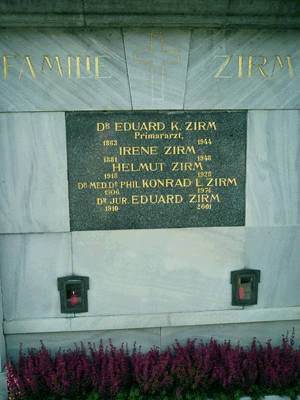A Ophtalmologist's journey
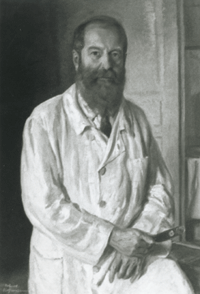
Dr. Eduard Konrad Zirm Painting, Family property |
Eduard Konrad Zirm was born in Vienna on March 18, 1863. Because of his father’s early death, his mother, Luise, was the steady, caring and sacrificing constant in his early years. She hid the difficulties from her children, Konrad and Adele, as best she could. Nevertheless, as soon as Eduard was old enough, he supported his mother and sister financially to the best of his abilities.
It was to become one of his great pleasures to be able to care
for his mother and sister. |
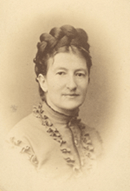 Luise Zirm His very beloved mother |
||||
“I was always a person of quick decision, and I still am today. So the next day I went to the Eye Clinic and stayed there” After his graduation from medical school he became an eye doctor at the Second Eye Clinic in Vienna, as the first assistant to Prof. Stellwag. His teacher, Prof. Theodor Billroth was one of his greatest supporters. Dr. Zirm wrote: “My
desire and aspiration was to follow surgery. Billroth was my role
model. |
||||||
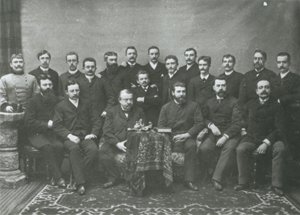 Second Eye Clinic in Vienna. Dr. Zirm is in the first row, third from the right. -- Family photograph. |
||||||
In
1892, the not yet 30year old was offered a position in Olomouc,
in Moravia. As usual in his life, he did not hesitate and went
to the Province, even though he was tempted by the idea of emigration
to the United States, like some of his colleagues. The Viennese doctor was very popular at that time, since he provided free treatment for patients with little or no money. At that time health insurance had not yet been established. During his years in Olomouc, between 1894 and 1928, Dr. Zirm performed 7866 eye cataract surgeries. He had only a small staff at his disposal for this. He also performed many corneal transplants (Keratoplastic) and further developed his methodology. Keratoplastic means corneal transplant, where the no longer transparent cornea is made transparent. As a balance to his stressful surgery, which he performed ambidextrously with both hands, depending on the position of the patient, he relaxed by gardening and beekeeping. |
||||||
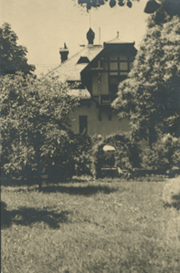 The family villa, designed by the gifted Doctor in Olomouc Family Foto |
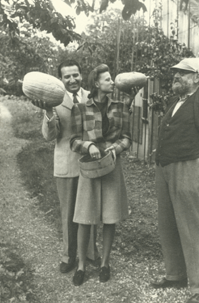 The Gardener Dr. Zirm with his son Eduard, daughter in law Rosemarie and rich harvest. Family Foto |
|||||
Further hobbies of the talented physician were playing the violin for his own enjoyment or accompanied with his wife and children or writing poetry, stories or his book. Before he completed all his scientific and clinical research he was forced to retire after 34 years of work. At that time Moravia had become a part of Czechoslovakia. The discoverer died on March 5, 1944 in Olomouc. After the war his remains were transferred to Graz, Austria, where his two sons, Dr. Dr. Konrad Zirm and Dr. Eduard Zirm lived. He was unable to remain in the crypt he had built as his last resting place for his ashes in his beloved garden. Instead he rests next to his beloved wife Irene at the cemetery of St. Peter. Often the pioneer work of many doctors is not recognized until decades later. Such was also the case for the surgical method of Dr. Zirm. It was applied and further developed abroad. After the October revolution in Russia, there was a need to catch up in ophthalmology. Vladimir Petrovitvh Filatow performed many corneal transplants even while Dr. Zirm was still alive. Among
his many descendants one son and four grandchildren have become
physicians: His
grandson, Univ.-Prof. Dr.
Mathias Zirm follows in his grandfather’s footsteps
and enriches the world of medicine through his outstanding work.
In November 2001 he received in the Oratorium of the Austrian
National Library the Medal of Honor for Science and Art of the
Austrian Albert Schweitzer Society. His grandson, Prim. Dr. Bernd Zirm leads the Provincial Hospital in Bad Radkersburg. His grandson Martin Terplan, MD His grandson Peter Terplan, MD Sein Urenkel Mischka Terplan, MD
The Family tomb in Graz |
||||||
